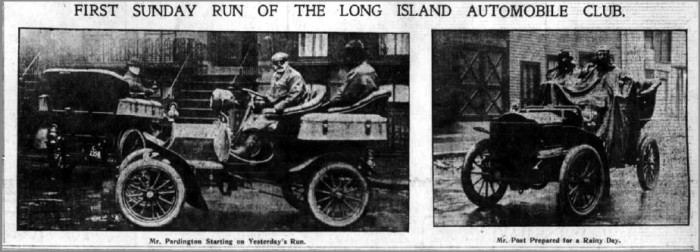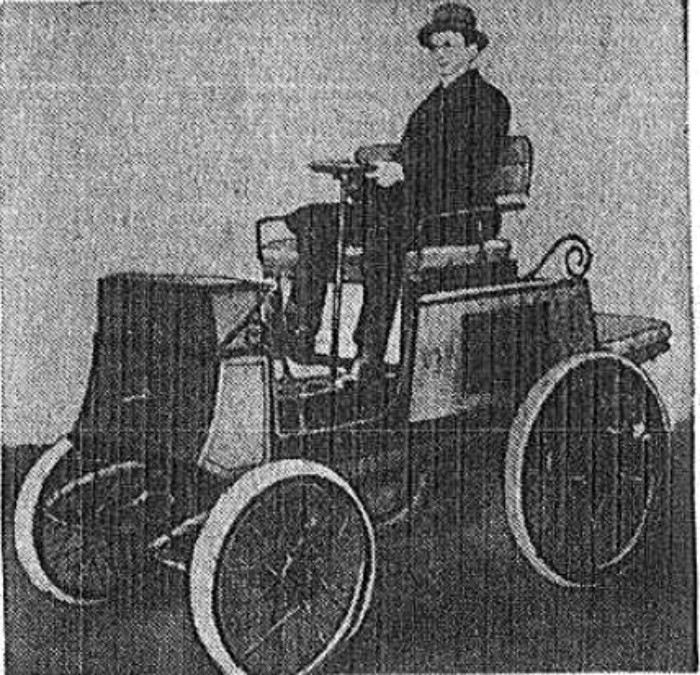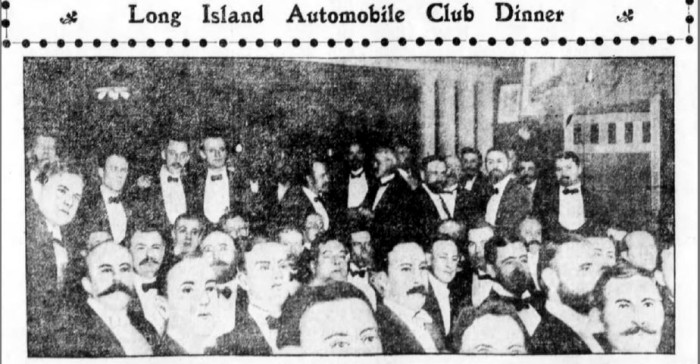Walkabout: Rollin’ Down the Highway, Part 1
Read Part 2, Part 3, and Part 4 of this story. By the turn of the 20th century, bicycling had become the most popular sport in New York, as well as a practical form of transportation. Almost anyone could afford a bicycle of some kind, whether new or used, and almost anyone; young or old,…


Read Part 2, Part 3, and Part 4 of this story.
By the turn of the 20th century, bicycling had become the most popular sport in New York, as well as a practical form of transportation. Almost anyone could afford a bicycle of some kind, whether new or used, and almost anyone; young or old, rich or poor, male or female could ride.
Cycling clubs brought people together for races, excursions and the shared love of biking and fun. The clubs and the sheer number of bikers had also successfully advocated for the improvement of streets. They put pressure on the city to pave more streets and open up dedicated biking paths.
Everything was going well for bikes and biking until the arrival of the car. When the first “horseless carriages” rolled down the street, they caught the imagination of the public like little has, before or since.
Like small children whose attention is caught by some new toy, for a certain segment of the population, the bicycle was dropped like an old stuffed bear, as the car was taken up and embraced like an old friend. At this stage of the automobile’s development, it was a toy for only the wealthy.
As quickly as the automobiles could roll out of the workshops, they were purchased by a select group of men who just as quickly formed clubs. Our story is about one of those clubs, Brooklyn’s own Long Island Automobile Club.
The first automobiles were not the sleek roadsters and touring cars of the Jazz Age, or even the practical designs of Henry Ford’s Model T’s. They were literally “horseless carriages.”
The first car makers had taken carriage bodies and put simple combustible engines and a steering wheel on them. They were not enclosed, nor were they comfortable. They did not go particularly fast, and they were not mass produced. But they were still the coolest things on earth.
Most of these early auto makers’ names and brands have disappeared from common memory. Many of them were carriage and coach makers who experimented with designs and engines.
The first cars did not roll down an assembly line, but had to be ordered, and were individually made. They were therefore quite expensive and could only be purchased by the rich.
But the turn of the 20th century was a time of great wealth for some, and by 1900, there were enough automobile owners in our cities that the idea of a club of enthusiasts was eagerly embraced.
The first automobile clubs in the United States were founded in Manhattan and Boston. The Manhattan Club was the Automobile Club of America, located on Fifth Avenue.
The third club founded was the Long Island Automobile Club, established in Brooklyn in 1900, by a handful of wealthy men.
They first met in rental club rooms at 102 Flatbush Avenue. Lewis R. Adams, the director of the Brooklyn, Bergen and Canarsie Railway was the first president of the club. Other members included Frank T. Webb, William J. Youngs and A.R. Pardington.
President Theodore Roosevelt is also listed as a member in one of my sources, but he appears nowhere else in the literature. He may have been an honorary member. T.R. does have the distinction of being the first president to ever ride in an automobile. He also summered in Long Island, and may have joined from there.
The club soon gained more members and moved from Flatbush to rented rooms at 552 State Street in December of 1900. They immediately put their initials in bright “automobile red and gold” lettering on the window of their headquarters, and ordered some furniture.
One of the main purposes of the club was to organize outings. Brooklyn had some great roads, as day trips to Coney Island and elsewhere had long been favorite activities for horse drawn carriage rides and then bicycle excursions. Their first trip as “autoists” as they were called, would hit all of the socially prominent sites in the city.
They planned to motor from their headquarters near the LIRR station over to Prospect Park, and ride through the park to Fort Hamilton Avenue. From there they would go over to the Shore Road and stop at the Crescent Athletic Club.
After resting there and no doubt, showing off to their members, they would continue along the Shore Road and visit either the Brooklyn Yacht Club or the Marine and Field Club before motoring up the Bay Parkway to Ocean Parkway, and back up to Grand Army Plaza.
If anyone wanted to drop out at that point, that was fine, but the die-hards were going to then motor over to Jamaica and back before heading for their clubhouse and the libations and celebrations to follow.
That may not sound like such a long trip today, but back then, they were sitting in open cars on barely padded seats, wrapped up against the winter chill with double breasted motoring coats, hats, gloves and goggles.
The cars were chugging along not much faster than a fast horse and carriage, and they shared the road with skittish horses that were not used to the sound of engines, which often backfired loudly.
They also didn’t really know how to drive these things all that well, and automobile technology had not yet come up with snow tires, or many of the other later advances in car design and function. For the wealthy Edwardian-era man, it was truly an adventure, and one trip was more than enough to want more.
The club realized that their goals of motoring all over Brooklyn, Long Island and the Tri-State area were being hampered by the lack of paved and maintained roads. They instituted a Good Roads Committee which was in charge of the task of lobbying the city, county and municipalities with paving and maintaining the roadways.
While that goal was self-serving, the club also knew that paved roads were good for the general economy, which was also good for their own business interests. Plus, they were prescient enough to know that their automobiles were the future.
New advanced in motor cars were being made every day, early buses and trucks were already appearing. The automobile was here to stay, and that required good roads.
It’s interesting that the autoists were also called “chauffeurs” in the early days. I read several accounts of the clubs rallying to obtain club rooms and accommodations for the “chauffeurs.”
I thought that very egalitarian, but soon realized the word applied to the club members themselves. The term chauffeur would soon have a much different meaning when the automobile replaced the horse and carriage as the primary means of private transportation.
In the meantime, the chauffeurs and autoists of the LIAC were continuing to expand their membership and their mission.
In 1901, the Automobile Club of America, the Long Island Automobile Club and clubs representing Chicago, Rhode Island, Utica, Princeton University, Grand Rapids, New Jersey and Philadelphia all came together to found the Automobile Association of America. (AAA)
Their official headquarters address was 753 5th Avenue, the home of the Automobile Club of America. Their membership was some 1,500 strong and growing. They founded the organization primarily as a lobbying group to advocate for better highways and roads.
At the time, there was a bill in front of Congress; the Brownlow-Latimer Bill, which called for the appropriation of federal funds for the improvement of national highways. AAA was in favor of it, and worked to get it, and subsequent funding laws passed.
That year, 1901, was also the year New York State became the first state to require automobile registration. Other states soon followed. For many years to come, the names, addresses and models of registered cars in the state was printed in a pamphlet and was public record.
It actually took quite a while before it was no longer possible or practical to print out the number of people who owned cars. The list was printed out until the end of the 1920s, and many copies can now be found on line.
Meanwhile, the Long Island Automobile Club continued to grow. They moved from State Street to the corner of Bedford Avenue and Fulton Street, in Bedford. They were now firmly ensconced in the sports pages of the Brooklyn Eagle.
The Club had added many more routes to their excursions, heading to destinations within Brooklyn, as well as out into Long Island. The beaches of Brooklyn and Long Island became popular destinations in the summer, and trips to the towns where many members had summer homes were also quite popular.
Members joined who actually lived in Long Island, but most of the club’s membership was from Brooklyn’s upper crust.
This was a men’s club. There were no women members, and wives and daughters are not seen in early photographs of their outings or dinners. In 1903, once again needing more room, the club moved back downtown to 32 Hanson Place, once a large automobile repair building.
They renovated it to their needs, adding a kitchen and banquet room, as well as general club rooms. They kept the garage space downstairs. According to the Eagle, the new clubhouse sported clubrooms paneled in Flemish oak wainscoting, with an inglenook fireplace on one wall.
It was described as very comfortable and homey. The garage space could hold 25 cars, and members could bring their vehicles here and tinker with them, either on their own, or with the help of an expert mechanic employed by the club.
The club’s agenda had expanded to charity work as well. They hosted an annual trip to Coney Island for children in orphanages and charity homes, forming large caravans of cars that brought the kids to the beach for a day of fun.
The event was very popular with members, as well as the children, and welcomed volunteers from outside the club to help shuttle the kids to the beach. It was quite the parade to see all of the cars filled with children on their way down Ocean Parkway to the beach.
As society changed and the automobile became more important to that society, the Long Island Automobile Club changed as well. They moved twice more before 1910. Several members became vital players in transportation ventures that helped shape the roads we travel on today. And of course, not everyone got along in every instance. More history of the Long Island Automobile Club next time.
(Photo:Long Island Automobile Club in 1905 Brooklyn Eagle.)











What's Your Take? Leave a Comment